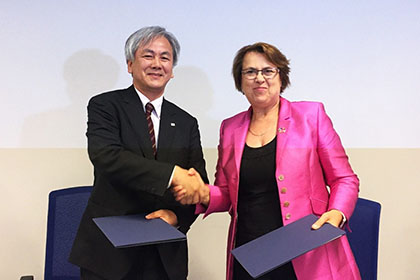This is an archive of information released in the past.
Disclaimer: It may contain broken links or outdated information. Some parts may not function in current web browsers.
*Visit https://humans-in-space.jaxa.jp/en/ for the latest information.

ISS/Kibo Times
The ISS/Kibo Times - Spring issue 2018 -
The ISS / Kibo Times will be issued quarterly to introduce Japan's activities on the Japanese Experiment Module "Kibo", the International Space Station (ISS), and the activities of JAXA Astronauts.
- - CONTENTS -
- ISS/Kibo Topics
- JAXA Astronauts Activities
- Recommended Videos
【1. ISS/Kibo Topics】
JAXA President Meets with Bhutan Prime Minister (April 13, 2018)
"Kibo" Experiment Handrail Attachment Mechanism (ExHAM) Development/Operation Team receives Space Frontier Award of Space Engineering Division by the Japan Society of Mechanical Engineers (May 7, 2018)
JAXA's "Kibo" Experiment Handrail Attachment Mechanism (ExHAM) Development/Operation Team was selected for the Space Frontier General Award of the 2017 Space Engineering Division hosted by the Japan Society of Mechanical Engineers (JSME) and awarded at the commendation ceremony on March 30, 2018.
JAXA's Activity of JEM Small Satellite Orbital Deployer (J-SSOD) win MEXT's Prize for Science and Technology in the 2018 Commendation (May 10, 2018)
JAXA's activity using JEM Small Satellite Orbital Deployer (J-SSOD) took Prizes for Science and Technology (in the Science and Technology Promotion Category) at the 2018 Commendation for Science and Technology by the Minister of Education, Culture, Sports, Science and Technology (MEXT), the latest in a series of accolades that the Ministry presents to those who have made noteworthy contributions in the fields of science and technology.
[Press Release] Successful Deployment of First Kenyan Satellite,selected as First KiboCUBE programme of UNOOSA and JAXA (May 11, 2018)
[Press Release] KiboCUBE: Team from the Republic of Mauritius Selected for Third Roundand Extension of KiboCUBE Cooperation Programme (June 19, 2018)

Signing ceremony of KiboCUBE programme extension during UNISPACE+50
(left: Mr. Masazumi Miyake, Director for International Relations and Research Department, right; Ms. Simonetta DiPippo, Director for UNOOSA)
(credit: JAXA/NASA)
CubeSats for BIRDS-2 handed over to JAXA. Launch preparations completed! (June 26, 2018)
On May 15, 2018, three CubeSats designed and developed in Japan by students from Bhutan, the Philippines, and Malaysia were handed over to JAXA at the JAXA Tsukuba Space Center, and started loading preparations for their launch.
Three CubeSats successfully deployed from "Kibo"! (June 26, 2018)
On May 11, three CubeSats developed respectively by Kenya, Turkey, and Costa Rica were successfully deployed from "Kibo."
Initiating the second joint exposed experiment on board "Kibo" with the Republic of Turkey (July 19, 2018)
On May 23, the second experiment of the collaboration mission between Japan and Turkey has been initiated using the Experiment Handrail Attachment Mechanism (ExHAM) of the Exposed Facility, an external platform outside the "Kibo."
JAXA's 3rd Mouse breeding mission finished (July 19, 2018)
The 3rd Mouse breeding mission (for 31 days from April 4 to May 5), which had been conducted on board the "Kibo", completed and the space-bred mice returned to Earth aboard the Dragon spacecraft (SpX-14) on May 6. The mission has brought the world's first achievement of the long duration stay in space and return all alive of gene-knockout mice.
CALET succeeds in direct measurements of cosmic-ray electron spectrum up to 4.8 TeV (July 19, 2018)
An international team of researchers succeeded in extending their result from a previous study and directly measured the cosmic-ray all-electron (electron + positron) spectrum in an energy range from 11 GeV to 4.8 TeV with the Calorimetric Electron Telescope (CALET). (Link to WASEDA Univ. website)
Amyloid β- protein "Amyloid fibril" extends under the microgravity environment - Flash analysis report of "Amyloid" space experiment handled by Astronaut Kanai - (July 19, 2018)
In January 2018, the first Amyloid Experiment to examine the formation mechanism of amyloid fibril (amyloid β: Aβ), considered as a factor of the onset of Alzheimer's disease, by using the microgravity environment of "Kibo." Astronaut Kanai was in charge of the experiment operation.
[Press Release] Launch Schedule of the H-II Transfer Vehicle KOUNOTORI7 aboard the H-IIB Vehicle No. 7 (July 13, 2018)
We have opened HTV7 web pages (July 13, 2018)
We have opened the HTV7 web pages. The HTV7 is scheduled to launch from the Tanegashima Space Center on September 11, 2018.
【2. JAXA Astronauts Activities】
JAXA Astronaut Norishige Kanai
[Press Release] Return of the Soyuz Spacecraft (53S/MS-07) with Astronaut Norishige Kanai aboard (June 3, 2018)
To find his full biography, please visit:
【3. Recommended Videos】
We introduce hot videos from the JAXA YouTube channel.
Next issue will be around the October, 2018.
Publisher: Human Spaceflight Technology Directorate, Japan Aerospace Exploration Agency
*All times are Japan Standard Time
| Copyright 2007 Japan Aerospace Exploration Agency | Site Policy |